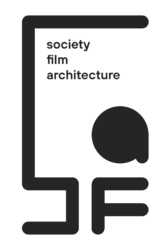
Architecture is deeply embedded in our society and culture, narrating the story of our progress, values, and aspirations. However, the deeper meaning behind a building’s design can often be elusive. Although we may admire the aesthetic elements of architecture, each structure holds a deeper essence. To genuinely understand and appreciate architecture, we must look beyond its physical structures and explore the stories it tells.
That’s where cinematography comes into play …

genre: ARCHITECTURE, CINEMATOGRAPHY AND ILLUSTRATION WORKSHOP
target group: architecture, visual arts & design, and letters students
workshop outcomes: Alternative posters & Literary and Film Chronicles
runtime: 2022 onward
season 1 (2022): Blade Runner & PostModernism
season 2 (2023): Metropolis & Modernism
season 3 (2024): A Clockwork Orange & Brutalism
season 4 (2025): … loading
SF(a) Project goals
SF(a) Society. Film. Architecture project consists of a workshop that encompasses both didactic elements, such as a series of lectures, as well as practical activities, like the design of an alternative movie poster. The activities aim to foster creativity, critical thinking, synthesis abilities, and cooperation skills. The secondary goal of the workshop is to promote a sense of belonging among students within a cohesive and interconnected educational framework.
The stated objectives encompass several key areas: fostering applied creativity among students, applying theoretical knowledge to real-world settings, critically analyzing a particular artistic work, namely a cinematographic achievement, acquiring practical skills through the design of a poster or alternative advertisement, developing graphic communication abilities through hands-on experience with contemporary graphic representation techniques, promoting competitiveness and adaptability, nurturing critical thinking skills, cultivating analytical abilities, and cultivating the development of synthesis skills.
SF(a) project involves the communication of knowledge in a variety of academic fields, including the artistic areas of photo-video art, cinematographic art, and contemporary philosophy, as well as urban sociology, history, and the theory of architecture. Group talks involved students engaging in collaborative conversations under the guidance of tutors.
Why dystopia?
What is the reason for the use of dystopia as an alternative education method? What could be the reason for not doing so? Architecture is not an isolated entity but rather a manifestation of societal influences. Similar to other visual arts encompassed under the realm of visual culture, architecture embodies the aspirations, values, and concerns of society. Nobody will ever design or build architecture simply for the purpose of communicating a message; similarly, nobody will ever propose the implementation of a dystopian society. However, it is essential to direct our attention towards the presence of dystopia in contemporary society, particularly within the current socio-cultural landscape. The concept of dystopia has evolved beyond its original purpose as a tool for deconstructing potential futures.
Target group and partners
On a voluntary basis, students enrolled in architecture, visual arts, and literature education as well as other fields constitute the target group. At the first edition (2022) there was a total enrollment of 25 students and in the subsequent iteration (2023) the number of participating students increased to 65. The lectures were accessible to both workshop participants and the public.
To facilitate these events, we collaborated with the A.S.A.I. student association and the Romanian Order of Architects, namely the Iași branch. The workshop was held over a period of six days, taking place between the end of June and the start of July.






